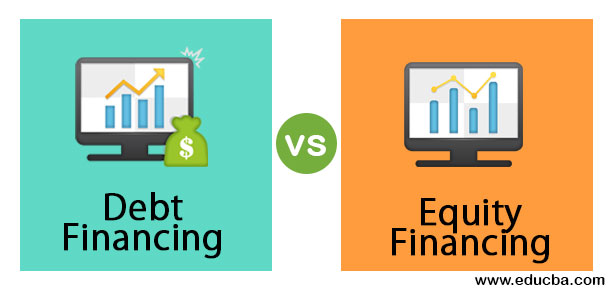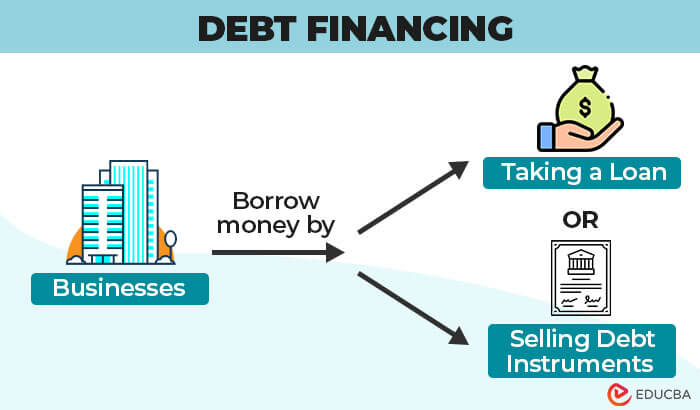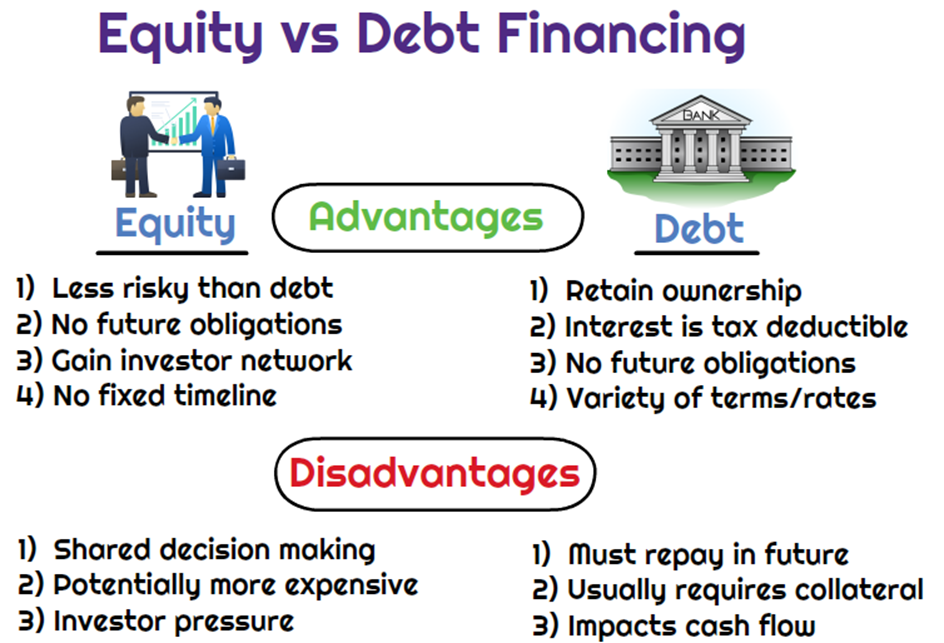When it comes to growing your business, finding the right financing options is crucial. One of the most common ways businesses choose to fund their growth is through debt financing. Debt financing involves taking on loans or lines of credit that are repaid over time with interest.
Toc
- 1. Introduction to Debt Financing
- 2. The Application Process for Debt Financing
- 3. Advantages and Disadvantages of Debt Financing
- 4. Managing Debt Responsibly
- 5. Bài viết liên quan:
- 6. Case Studies: Successful Debt Financing Examples
- 7. Top Debt Financing Choices in US 2024 for Small Business
- 8. Conclusion
Introduction to Debt Financing

Debt financing can be a powerful catalyst for small business growth, offering access to capital that fuels expansion, innovation, and increased market presence. However, understanding and leveraging this financial tool effectively is essential for reaping the benefits without succumbing to pitfalls.
What is Debt Financing?
Debt financing involves borrowing money to be repaid over time with interest, as opposed to equity financing, where ownership shares are sold in exchange for capital. Debt financing allows you to retain full control of your business while providing the funds needed for growth. It can come in various forms, including traditional bank loans, lines of credit, equipment financing, and more.
Types of Debt Financing
There are several types of debt financing options available to businesses:
- Traditional Bank Loans: These loans are typically offered by banks and require collateral and a strong credit history.
- Lines of Credit: Similar to a credit card, a line of credit allows you to borrow funds as needed up to a predetermined limit.
- Equipment Financing: This type of financing is specifically used to purchase equipment and is secured by the purchased item.
- SBA Loans: These loans are partially guaranteed by the Small Business Administration and offer more favorable terms for small businesses.
- Invoice Financing: Also known as accounts receivable financing, this option allows businesses to borrow money against unpaid invoices.
Benefits of Debt Financing
Debt financing offers several benefits for businesses looking to fund their growth:
- Lower Cost: Compared to equity financing, debt financing is often less expensive because it doesn’t involve giving up ownership stake in the business.
- Flexibility: With various types of debt financing available, businesses can choose the option that best fits their needs.
- Retain Ownership and Control: Unlike equity financing, where investors may have a say in business decisions, debt financing allows you to retain full control of your business.
Potential Risks of Debt Financing
While debt financing can be beneficial for growth, it also carries some potential risks:
- Interest Payments: Taking on debt means paying interest on top of the original loan amount. If not managed properly, these payments can become a burden on cash flow.
- Collateral Required: Some forms of debt financing may require collateral, which puts assets at risk if the loan cannot be repaid.
- Negative Impact on Credit: If debt is not managed well, it can negatively impact a business’s credit score and make it harder to secure future financing.
The Application Process for Debt Financing

To successfully obtain debt financing, businesses must go through a rigorous application process:
Steps Involved in Applying for Debt Financing
- Assess Your Needs: Determine how much capital you need and how it will be used.
- Prepare Documentation: Gather financial statements, tax returns, a business plan, and credit reports.
- Research Lenders: Compare different lenders and their offerings to find the best fit.
- Submit Application: Provide detailed information about your business and its finances.
- Review Terms: Carefully review the loan terms, including interest rates, repayment schedules, and any fees.
- Approval and Funding: Once approved, the funds will be disbursed according to the agreed-upon terms.
Tips for a Successful Debt Financing Application
- Maintain Good Credit: Lenders will consider your credit history when evaluating your application, so make sure to maintain good credit.
- Prepare Financial Statements: Having well-organized and up-to-date financial statements will make the application process smoother.
- Understand Your Business Plan: Be prepared to explain your growth plans and how the funding will contribute to achieving them.
- Communicate with Lenders: If you have questions or concerns, don’t be afraid to communicate with potential lenders. This can help you understand their requirements better and improve your chances of approval.
What Lenders Look For in Small Business Borrowers
- Creditworthiness: A strong credit score and history of repaying debts.
- Financial Health: Solid financial statements and cash flow projections.
- Business Plan: A clear plan outlining how the borrowed funds will be used and how they will generate returns.
- Collateral: Assets that can secure the loan in case of default.
Advantages and Disadvantages of Debt Financing

As with any financial decision, there are both advantages and disadvantages to debt financing. It’s essential to carefully consider these factors before deciding to take on debt for your business.
Advantages of Debt Financing
- Total Control: Retain control over decision-making without giving up ownership.
- Tax Benefits: Interest payments and some fees associated with debt financing can be tax-deductible.
- Lower Cost: As previously mentioned, debt financing can be a less expensive option compared to equity financing.
Disadvantages of Debt Financing
- Risk of Insolvency: If the business is unable to make loan payments, it could lead to insolvency and potential closure.
- Interest Payments: The cost of borrowing money includes paying interest, which can add up over time.
- Limited Access for Small Businesses: Lenders may have strict requirements that small businesses may not meet, making it more challenging to secure debt financing.
Managing Debt Responsibly

To reap the benefits of debt financing while mitigating risks, businesses must manage their debt responsibly. Some tips for responsible debt management include:
Tips for Responsible Debt Management
- Create a Repayment Plan: Outline how you will meet your repayment obligations.
- Monitor Cash Flow: Regularly review your cash flow to ensure you can cover debt payments.
- Seek Professional Advice: Consult with financial advisors to create a comprehensive debt management strategy.
- Avoid Overleveraging: Taking on too much debt can lead to financial strain and impact the business’s ability to grow.
- Stay Organized: Keep track of all loan agreements, terms, and repayment schedules to avoid missed payments or penalties.
The Role of Financial Advisors
Financial advisors can provide valuable insights into the best debt financing options for your business and help you develop a repayment strategy that aligns with your financial goals. They can also assist with monitoring cash flow and identifying potential issues before they arise. Overall, working with a financial advisor can help businesses manage their debt responsibly and ensure long-term financial stability.
Bài viết liên quan:
- https://vaytienonline.co/secure-your-tomorrow-the-essential-financial-planner-guide-for-professionals/
- https://vaytienonline.co/qfin-platform-revolutionizing-financial-technology-for-investors/
- https://vaytienonline.co/mastering-smart-finance-essential-debt-management-strategies/
- https://vaytienonline.co/securing-your-golden-years-the-role-of-a-financial-advisor/
- https://vaytienonline.co/navigating-financial-waters-the-value-of-a-business-financial-consultant/
Importance of Financial Forecasting
Accurate financial forecasting helps you anticipate future cash flow needs and ensures you can meet debt obligations without compromising other business operations. It also allows you to identify potential issues early on and make necessary adjustments to avoid financial strain.
Case Studies: Successful Debt Financing Examples

- Airbnb: In 2011, Airbnb raised $112 million in debt financing from Western Technology Investment to fuel its rapid growth.
- Peloton: The popular at-home fitness company raised $550 million in debt financing to fund its expansion and launch new products.
- Warby Parker: The eyewear company secured $100 million in debt financing from J.P. Morgan to support its growth and expansion plans.
These examples show how successful companies have utilized debt financing as a strategic tool to achieve their goals and accelerate their growth. However, it’s crucial for businesses to carefully consider their financial situation and needs before taking on debt. Responsible management of debt can provide a valuable source of capital for businesses, but it should always be approached with caution and careful planning.
Airbnb’s Journey with Debt Financing
Airbnb’s strategic approach to debt financing has played a significant role in its ability to scale rapidly and establish a presence in a competitive market. After initially focusing on equity funding, the company pivoted to debt financing as it matured, utilizing it as a tool to enhance its liquidity and support its growth initiatives. The $112 million debt financing from Western Technology Investment in 2011 allowed Airbnb to invest in technology enhancements, marketing, and global expansion, which were vital during its scaling phase.
This method of financing not only provided the much-needed capital but also enabled the company to maintain its operational autonomy. By retaining ownership and control over its business direction, Airbnb could focus on executing its vision without the pressures often associated with external equity investors. The careful management of these funds and a proactive approach toward meeting repayment obligations exemplified Airbnb’s commitment to responsible financial stewardship, setting a precedent for other businesses considering similar financing routes in the future.
Expert Insights and Quotes
- “Debt financing can be a strategic tool for small businesses looking to grow, offering access to capital without giving away equity.” – John Doe, Small Business Financial Advisor
- “Understanding the right type of debt for your business and having a clear repayment plan is key to leveraging debt financing effectively.” – Jane Smith, CEO of GrowingTech Co.
- “Small businesses should view debt financing as a partner in growth, not a burden, but it requires careful planning and financial management.” – Alex Johnson, Small Business Lender
- “We’ve seen many of our clients transform their operations and scale their businesses with the right debt financing in place.” – Maria Rodriguez, SBA Loan Specialist
Top Debt Financing Choices in US 2024 for Small Business

As we look into 2024, small businesses have access to a variety of debt financing options tailored to meet their unique needs. Understanding these options is crucial for making informed financial decisions. Here are some of the most popular debt financing choices available:
Traditional Bank Loans
Traditional bank loans remain one of the most reliable sources of debt financing for small businesses in 2024. These loans typically offer lower interest rates compared to alternative financing methods due to the established nature of banks. However, securing a traditional bank loan often requires a solid credit history, collateral, and a detailed business plan. To improve the chances of approval, businesses should prepare financial statements and forecasts that demonstrate their ability to repay the loan over time. For example, a business may use its accounts receivable or inventory as collateral to secure the loan.
Small Business Administration (SBA) Loans
The SBA offers guaranteed loans to small businesses through their lending partners, including banks and other financial institutions. These loans offer more flexible terms compared to traditional bank loans and can provide larger amounts of capital for businesses with limited assets or credit history. The most popular SBA loan programs include 7(a) loans, which can be used for general business purposes, and 504 loans, which are specifically designed for real estate and equipment financing.
Alternative Financing Options
In recent years, alternative financing options such as online lenders and peer-to-peer lending platforms have gained popularity among small businesses. These options often offer faster approval times and more flexible requirements compared to traditional financing methods, making them attractive for businesses with immediate funding needs. However, they may come with higher interest rates and fees, so it’s essential to carefully consider the terms before committing to these options.
Conclusion

In summary, debt financing can be a powerful tool for businesses aiming to expand and innovate without sacrificing ownership. While there are advantages such as lower costs and potential tax benefits, businesses must be mindful of the associated risks, including the possibility of insolvency and the burden of interest payments. Successful management of debt involves creating a robust financial strategy that includes solid forecasting, diligent monitoring of cash flow, and a commitment to timely repayments. Case studies from notable companies like Airbnb, Peloton, and Warby Parker illustrate the effectiveness of debt financing when executed responsibly. By leveraging the insights of financial advisors and adhering to best practices in debt management, businesses can harness the full potential of debt financing to support their growth ambitions. Ultimately, approaching debt with caution and foresight will help ensure long-term viability and success in a competitive landscape.
References and Additional Resources
- Small Business Administration (SBA) – Comprehensive information on SBA loans.
- Score – Free business mentoring and training.
- The U.S. Chamber of Commerce – Resources on financing and growing your business.
- NerdWallet – Compare business loans and lenders.
By exploring these resources and seeking professional advice, you can make informed decisions about debt financing and set your business on a path to sustainable growth.











